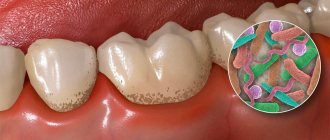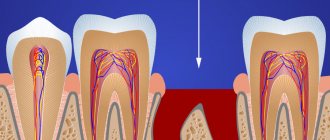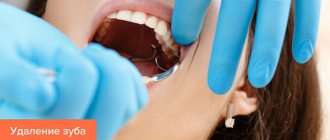From this article you will learn:
- Why does pain occur after wisdom tooth removal?
- What are the complications after wisdom tooth removal?
- what to do if you have swelling of your cheek or bleeding from the socket of an extracted tooth.
After wisdom tooth removal, patients may experience various symptoms - pain, swelling of the gums or cheeks, fever, painful opening of the mouth, painful swallowing, etc. Depending on the initial situation (for example, the removal was carried out against the background of inflammation, the removal was difficult...) - these symptoms may be natural, or they may, on the contrary, signal the development of complications.
What to do after wisdom tooth removal
On this day, it is better to go home and relax: sleep, read a book, watch your favorite show or movie. It is not recommended to move a lot and intensively, or engage in physical labor.
Starting from the second day, it is necessary to rinse your mouth with antiseptics and take antibiotic medications to prevent the development of infectious and inflammatory diseases. The doctor decides which antibiotics to take after wisdom tooth removal. If there are no recommendations, then you can choose any medications with a wide spectrum of action.
Intense rinsing is not recommended, licking the blood clot is strictly prohibited, otherwise this will lead to the effect of a dry socket. A plug of clotted blood protects the resulting cavity and jaw bones from food particles and bacteria getting inside.
Do not consume hot or too cold foods, drinks, or overheat the body. Visiting the beach, baths, saunas is prohibited.
Smokers will have to give up cigarettes for 2, 3 days, or better yet for a week. Nicotine does not allow the wound to heal quickly, as it constricts blood vessels. Tissues are poorly saturated with oxygen and nutrients, and are more easily susceptible to infection.
A repeated visit to the doctor is necessary, even if the stitches do not need to be removed. The doctor will examine the wound, be able to identify complications in time and prescribe the correct treatment. You should not wait until the date of re-appointment if there is severe, ongoing pain, or the appearance of pus in the socket.
When to sound the alarm
- It happens that removal turns out to be difficult. Then the doctor warns the patient in advance about possible complications and tells him to come for a follow-up appointment in the coming days. You should sound the alarm if:
- Symptoms of a viral disease are observed. Then the fever persists for longer than three days. Cough, runny nose, and throat congestion appear. Efficiency decreases.
- After one or two days the temperature does not decline, but on the contrary, begins to rise. If it stays at 38.5-39 degrees throughout the day, you should seek medical help as soon as possible.
- Signs of inflammation in the oral cavity have become more pronounced. The gums are more swollen, accumulations of pus are visualized in the socket area, and there is no blood seal. This indicates complications.
Dry socket is especially dangerous. They talk about it if a dense blood clot does not form at the site of the pulled out tooth. The wound remains open to infection, which means that regenerative processes do not proceed correctly.
If your temperature rises after wisdom tooth removal
The symptom may occur immediately after extirpation. This is due to the action of the immune system in response to tissue injury and invasion of foreign elements into the body.
Doctors recommend taking antipyretics and using cold compresses to remove heat locally.
If the patient then develops a fever several days after extirpation, this may indicate the presence of an inflammatory process. The most common is alveolitis. It is accompanied by acute pain, which can radiate to the throat, temple, ear, depending on where the hole is located. If, when you probe the hole with your tongue, you feel an empty cavity, then you need to urgently go to the dental clinic where the surgery was performed.
When is elevated temperature normal?
Very often, after a tooth is pulled out, a person experiences various unpleasant symptoms. They are due to the fact that the figure eight has long and winding roots. It is also far away and always difficult to get to. In the absence of free access to the crown, removal always turns out to be quite traumatic.
In the first two days after extraction of the unit, the following phenomena are considered normal:
- increase in body temperature to 37-38°C;
- swelling and redness of the socket;
- pain in the wound area;
- general weakness.
If healing proceeds without complications, these symptoms disappear within one to two days. Of course, swelling and soreness take longer to go away, but body temperature should not remain elevated for a long time.
How to relieve pain after wisdom tooth removal
The doctor prescribes drugs for pain relief to the patient. If there is no list, but the pain is severe, then you can buy Tempalgin, Baralgin, Ketanov and similar medications. Medicines must be taken according to instructions. If you take too many tablets, it will lead to side effects. One tablet is usually enough to stop an attack. Take three times a day.
In addition to medications, pain can be reduced with cold. A cold compress is applied to the cheek for 15 to 30 minutes up to four times a day. You can use pieces of ice or frozen food from the freezer. They are placed in a plastic bag and a towel, and then applied to the sore spot.
If there is bleeding
After difficult removal of the figure eight, bleeding may occur. It needs to be installed, but it is not always possible to do this in a short time. In severe cases, the dental surgeon places sutures on the postoperative wound and performs tamponade. Then the patient is recommended to apply a cold compress to the cheek for some time. It helps stop bleeding and quickly relieve swelling.
It is very important to understand what causes bleeding after surgery. Among the most common reasons:
- arterial hypertension or a sharp one-time increase in blood pressure;
- the use of anesthetics containing adrenaline (such drugs help dilate blood vessels);
- injury to the wound with the tongue or foreign objects;
- taking medications that reduce blood clotting;
- performing heavy physical work shortly after the intervention.
If bleeding continues throughout the day, this is abnormal. In such a situation, it is recommended to make an appointment with a doctor.
What can you eat after wisdom tooth removal?
It is forbidden to put anything in your mouth for two hours after extraction. During this time, a plug of condensed blood is formed and fixed on the socket, which is necessary to protect against the entry of various elements, including pathogens. If you are very thirsty, you can do this through a straw or in small sips.
On the first day, you can drink non-hot drinks and eat liquid porridge, yogurt, and soups. Over the next few days, you should adhere to the following recommendations:
- food must be at a comfortable temperature; hot and too cold food is prohibited, including drinks;
- it is necessary to exclude solid foods that can injure the gums;
- You need to chew food on the side that has not undergone surgery;
- After each dose, you need to rinse your mouth with a warm saline solution;
- If your immune system is weakened, you can take additional multivitamins.
It is better to refuse or limit sweet, spicy foods, alcohol, and carbonated drinks.
Is it possible to treat teeth if you have a cold?
If the high temperature is caused by ARVI, herpes or other infectious diseases, then it is better to reschedule the appointment. The body at this moment is weakened and tuned to eliminate the disease, which means that the recovery process after dental treatment will be delayed. If you have a runny nose or cough, it will be difficult to sit in the dental chair during treatment. In addition, there is a high risk of spreading infection to the staff and other patients of the clinic.
However, there are situations when treatment cannot be delayed. In this case, you need to consult with your doctor, preferably by phone. He will decide whether to subject the weakened body to dental intervention or not.
How to rinse your mouth after wisdom tooth removal
The first few hours after extirpation, rinsing is strictly prohibited. This can lead to the natural plug being washed away, exposing the socket and bone. If bacteria penetrate inside, alveolitis or osteomyelitis will develop.
From the second day, carefully, not intensively, rinse your mouth with various antiseptics:
- chlorhexidine;
- miramestin;
- furatsilin;
- diluted potassium permanganate.
At home, you can prepare a solution with salt, soda, and add a few drops of iodine to the water. Herbal decoctions with sage, eucalyptus, chamomile, calendula, and oak bark perfectly relieve swelling and inflammation.
In what cases can you lower the temperature yourself and by what means?
There is no need to lower the temperature to 38 degrees.
The formation of a blood clot, the absence of infection of the socket and the remains of the wisdom tooth root in it indicate its successful extraction.
With such a clinical picture, there is no need to fear the development of complications. But, it is worth understanding that after such manipulation, in the first 2–3 days there is a high probability of an increase in body temperature within 39 degrees.
If its readings do not exceed 38 degrees, then there is no need to lower this temperature. This low-grade fever is a natural reaction of the body that helps fight a bacterial infection.
If the indicators begin to increase and remain for more than 3 days, it is necessary to suspend this process. For these purposes, it is recommended to use pharmacological antipyretics and preferably with an antibacterial effect.
Among them, the most popular are:
- Nemisil.
- Paracetamol.
- Nurofen.
- Efferalgan.
- Nimulid.
Reference! Many antipyretic drugs have a large list of contraindications and side effects, so they should be prescribed exclusively by a dentist.
How long does it take for gums to heal after wisdom tooth removal?
It is impossible to answer this question unambiguously, since the answer depends on the following factors:
- difficulties of extirpation - with a simple procedure, the tissues are minimally injured, which means the hole will heal within a few days; with incisions in the gums, the tissues heal for several weeks;
- age - faster for young people;
- the presence of complications, inflammatory processes that delay healing indefinitely until the infection is eliminated;
- compliance with doctor's instructions for the rehabilitation period;
- individual characteristics of the body.
Dentist help
If you experience accompanying alarming symptoms, be sure to consult a doctor!
If alarming dynamics occur in parallel with body hyperthermia, you should immediately visit a doctor. During the examination, you must describe in detail the symptoms that are bothering you. The dentist will conduct a visual examination of the oral cavity and order an x-ray.
After a full examination and diagnosis of the cause of the increase in body temperature, the specialist chooses a method of providing assistance.
- If there is a cyst or root remains in the socket, they are removed using local anesthesia. Next, the wound is treated with antiseptic solutions, and a course of antibacterial therapy is prescribed.
- In the presence of additional mechanical damage to the tissues near the extracted tooth. These may be ruptures of the cheek, periodontal tissue, sharp edges of the jaw or alveoli. To eliminate such defects, the damaged tissue is cut off, followed by straightening the deformed area. If necessary, stitches are placed and a sterile tampon is placed to stop bleeding for 15 to 25 minutes.
Regardless of the type of care provided, it is necessary to strictly follow medical prescriptions and carefully monitor oral hygiene in the postoperative period. This will not only speed up the recovery process, but also prevent the development of serious complications.
Postoperative actions
Preventive measures consist of the following actions:
- Antiseptic treatment (for example, Rotokan or Burana 400 solution).
- Sanitation.
- Carrying out regular hygiene procedures.
- Using traditional methods.
In folk medicine, calendula, chamomile, St. John's wort, sage and calamus are used. They use traditional methods in parallel with medications.
On the day of removal, you should not visit the bathhouse or eat hot or cold food. It is necessary to thoroughly avoid contact with sick people, beware of winds and drafts. You should not eat too hard foods, so as not to damage your painful gums. Do not drink alcohol or consume hot spices.
Visit doctor
The time to see a doctor should not depend on when the fever started: today or has already lasted 3 days.
If side symptoms are present, help should be provided immediately. Symptoms include:
- Nauseating odor from the mouth.
- Temperature above 38ºС.
- The pain is constantly increasing.
- The gums swelled and became red.
- The cheek is swollen.
- The lymph nodes are inflamed.
- The removal site festers.
The doctor will conduct a survey and order an x-ray, which will show the reason for such a long high temperature.
If a root was left behind, the dentist will remove it and thereby remove the inflammation. Typically, after surgery, an antiseptic is treated and a course of antibiotics is prescribed. For granuloma and cyst, the actions taken by doctors are similar.
If, after a previous visit to the dentist, the patient’s cheek or gum is torn, the doctor will make stitches and apply a sterile bandage.
If sharp edges of the bone were left, the doctor will smooth them with a special tool.
Be aware that repeated intervention will lead to a rise in temperature again. But this will already be a completely normal and encouraging phenomenon.
Acute and chronic odontogenic sinusitis
This form of sinusitis is quite painful. This occurs due to the connection between the acute form and inflammation in the area of the tooth root. However, if there are always persistent dental problems, acute sinusitis can develop into chronic inflammation of the antral sinus. The two forms of sinusitis differ in their symptoms.
Acute dental sinusitis manifests itself:
- Severe throbbing pain;
- Swelling around the cheek (can reach up to the eyelid);
- Redness of the nasal wall and turbinates;
- Secretion from the nose is mucopurulent in nature.
In addition, pressing on the affected area may cause pain. Acute dental sinusitis is usually accompanied by fever.
Signs of the chronic form of odontogenic sinusitis are often much less pronounced. Some patients experience symptoms only occasionally, such as occasional headaches.
How does dental sinusitis develop?
The paranasal sinuses (sinus paranasales) consist of a system of several cavities in the near-nasal space.
In the case of a cold, less ventilated sinuses are especially susceptible to developing sinusitis. The maxillary sinuses (sinus maxillaris, maxillary) are relatively well ventilated. However, the floor of the maxillary sinus is separated only by a narrow bony plate from the molars of the upper jaw. Due to this anatomy, the development of dental (odontogenic) sinusitis is quite common. The main cause of odontogenic sinusitis may be inflammation that forms in the area of the roots of the teeth and easily spreads to the mucous membrane of the maxillary sinus. Common pathogens include bacteria such as:
- Streptococcus pneumonia - streptococcus;
- Haemophilus influenza – hemophilus influenzae;
- Moraxella catarrhalis is a protobacterium of Moraxella.
Odontogenic maxillary sinusitis can also form due to tooth extraction (extraction). If one of the maxillary molars is removed, with damage to the bone grafting of the upper jaw, bacteria from the oral cavity can enter the sinus. In this case, they talk about the formation of an unnatural connection between the oral cavity and the paranasal sinus - an oroantral fistula. This trigger factor is considered one of the common causes of “dental” sinusitis.
A third dental cause of sinusitis involves inflamed roots that go unnoticed. As a result, cysts are formed that “grow” into the sinus cavity.











